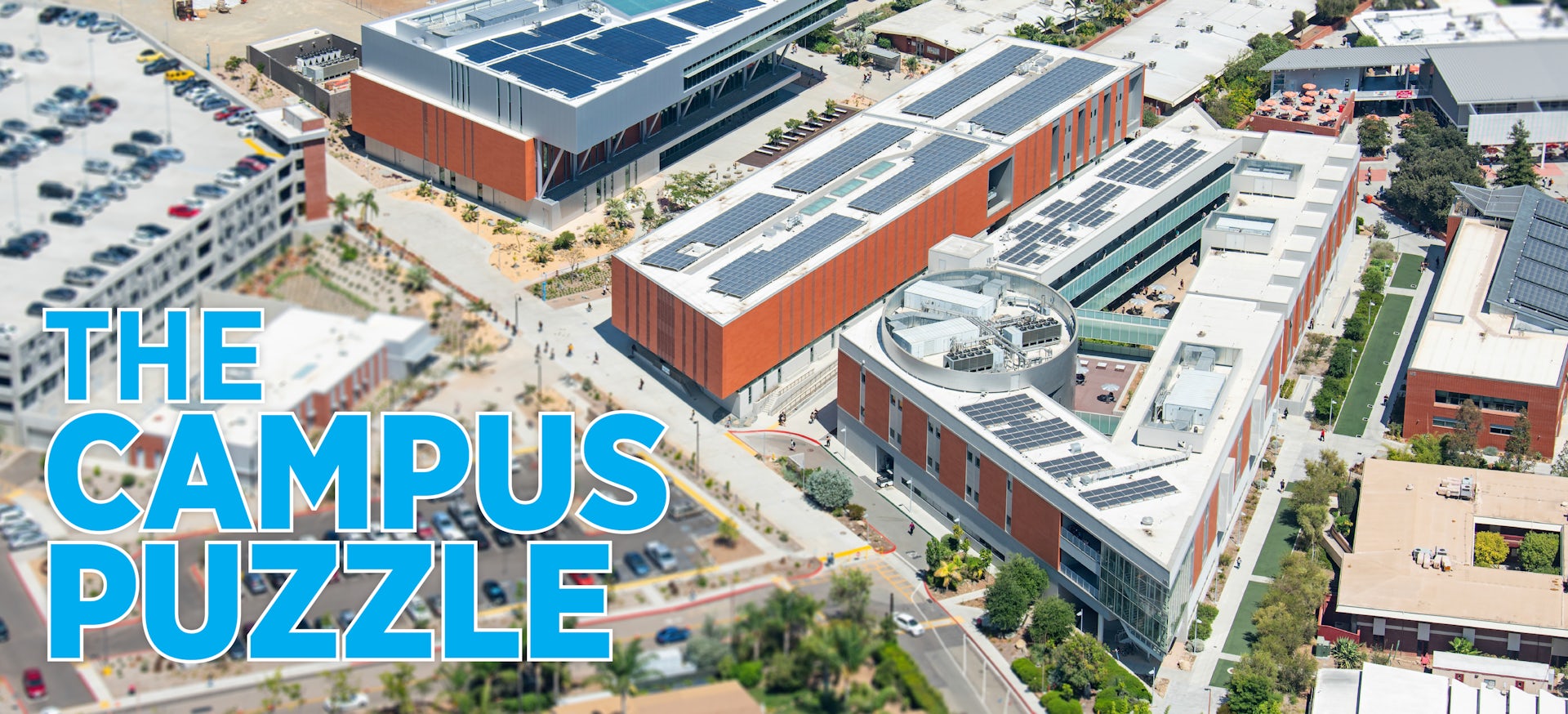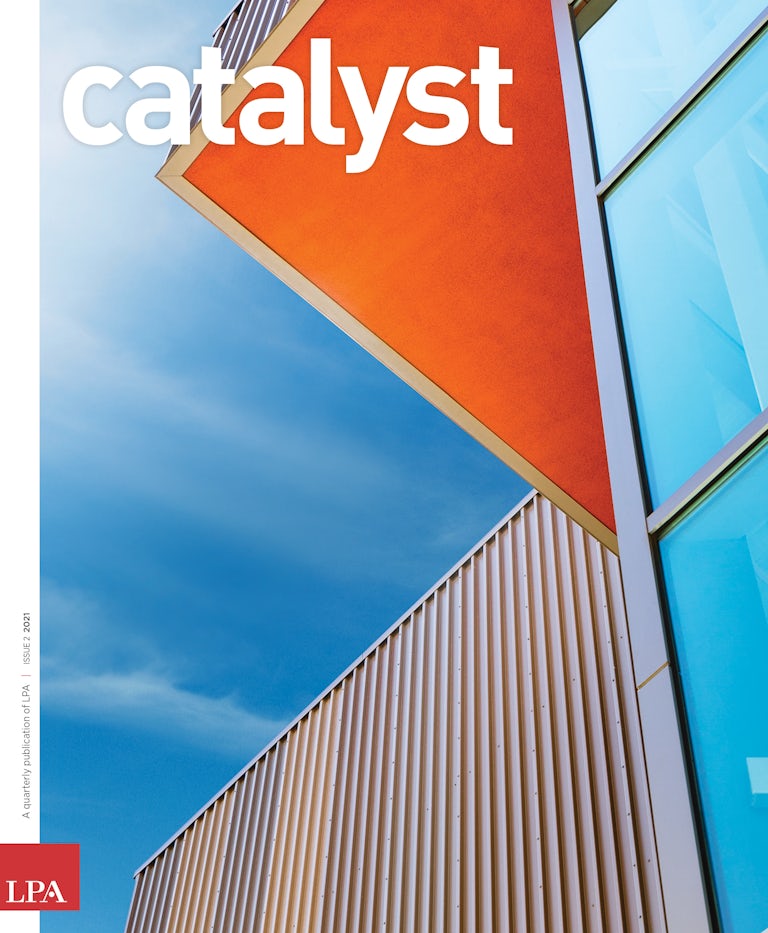Every component of a university or college campus should fit together to support students’ needs and the institution’s larger mission. Bringing the pieces together — campus building — is a specialized art form.
When California State College, San Bernardino opened in 1965 with 293 students and 30 faculty members, it primarily served local commuter students. Since earning university status in 1984 and officially becoming California State University, San Bernardino, CSUSB has grown to more than 19,000 students and evolved as a university that seeks to redefine itself around student life and concepts of engagement and collaboration, inside and outside the classroom.
Over the last decade, university stakeholders and LPA have been collaborating on a series of projects that, taken together, have changed the campus culture, including the College of Education Building, the recently completed LEED Platinum-certified Center for Global Innovation (CGI) and the ongoing expansion of the existing student union. LPA’s integrated design team introduced new buildings and landscape interventions that knitted together a complex of new facilities into engaging and interactive spaces linked by a main pedestrian promenade and public indoor and outdoor social spaces.
“LPA understood our values, where we’ve been and where we’re going,” says Jennifer Sorenson, Associate Vice President Facilities Planning & Management.
Campus building — the concept of bringing together elements to make something larger than the sum of the parts — is a much different endeavor than master planning. While campus master plans establish a guiding framework for campus development, campus building is the physical manifestation of implementing an institution’s master plan. With each new project, design professionals have a responsibility to deliver contextually appropriate solutions that respect the history of each campus yet deliver forward-thinking designs that will provide tangible benefits and inspire tomorrow’s leaders.
Adding new buildings to a campus resembles a game of chess; every move on the board has immediate and future impacts, says LPA project designer Ozzie Tapia. Many of the key challenges facing college campuses today — overcoming tight budgets, bringing students back to campus, serving new students’ needs, engaging with the community, reinventing social and academic life — require solutions that optimize existing spaces and structures to serve new roles. While there is not a one-size-fits-all approach, designing to the students’ and educators’ specific needs will always add value to the campus.
“New facilities should have a dialogue with and respect the comprehensive campus fabric but have enough character and purpose-driven unique features to stand on their own,” Tapia says.
It's not what building goes where. It's about how students circulate and interact, and how we make sense of existing buildings to improve campus flow.
For California State University, Northridge, LPA’s design for the Student Recreation Center turned a challenging site — a narrow lot on a nondescript edge of the campus — into a vibrant gateway. The fringe site was transformed into an iconic destination with improved walkways and pedestrian access, an added connection to mass transit and a three-story glass facade that showcases indoor activities as a “human billboard.” In a similar fashion, at West Valley College in Saratoga, California, near San Jose, the modernized Cilker School of Art and Design and the Che School of Professional Studies completely redefined the campus landscape with retractable garage-style doors and glass façades on exterior classrooms, providing visitors and students a new first impression of the campus.
Different elements of a single project can also have larger implications for a campus. The expansion of CSUSB’s Student Union includes features that have been employed and continue to be repeated throughout the campus, including deep overhangs and shade structures to create more usable outdoor spaces; student-centric social and engagement spaces with direct access to views and natural daylight; enduring and low-maintenance materials to withstand the harsh heat and strong winds; and an expansive rooftop solar panel array — all underscoring a student-funded project and their commitment to environmental stewardship and return on investment for the university.
“Any time we put pen to paper for a campus project, we think about how we get students out of their cars or residence halls and onto the campus,” says Steve Flanagan, LPA’s Director of Higher Education. “It’s about understanding how the campus community navigates and interacts and how we connect with existing buildings and amenities to improve the campus experience.”
New additions are guided by master plans, snapshots in time that reflect an extensive needs analysis and serve as a tool to guide the vision. But over decades and generations, as student needs, pedagogy and design evolve, adding new buildings to campuses has become more about improving the campus lifestyle as a whole, rather than simply finding open space. In today’s competitive landscape, campuses must be able to respond to changing priorities and students’ evolving needs.
The design approach for any campus project should seek to create vignettes and develop building clusters as villages, connecting programming with outdoor spaces and landscaping strategies, Flanagan says. “It’s time to reinterpret notions of the classic oversize campus quads of legacy universities,” he says.
LPA’s work at CSUSB exemplifies the potential in taking a holistic, progressive approach. The integrated design for each building, including engineers and landscape architects from the earliest stages, resulted in more efficient buildings that connect to the outdoors and serve several roles. These projects transcend their footprint and consider more far-reaching impacts that will ripple throughout the campus, such as site ecology, biodiversity, water, the climate and natural settings.
In the case of the Center for Global Innovation (CGI), a home for the growing international student body and professional learners, LPA took proposed plans that placed it on the edge of campus — near the ring of parking lots — and relocated it to the heart of the campus. The new CGI complements classic campus and formal buildings, such as the neighboring John M. Pfau Library, which opened in 1971, and the adjacent Coyote Walk, a major pedestrian mall on campus. Designers leveraged the addition of the CGI to craft a gateway experience into the central campus, with building lobbies and classrooms designed with direct connections to the exterior. New landscaping and shaded outdoor seating were formed by the building’s unique, three-tiered form. The lobby extends to the surrounding outdoor seating, creating an expansive and thriving indoor-outdoor campus living room.
“We didn’t have much usable outdoor space, and students really didn’t congregate outside,” Sorenson says. “But in just the short time the Center for Global Innovation has been open, it’s become a heavily utilized site that offers students an amazing interaction space.”
For Palomar College in San Marcos, California, LPA has served as both master plan and project architect. As a result, every addition to the campus has a consistent approach and alignment with the college’s larger goals. Each project presented unique challenges, but they also created important opportunities to develop iconic destinations, while strengthening the character and community fabric of the campus.
The 85,000-square-foot, four-story Palomar College Learning Resource Center (LRC), opened in 2019, is part of a decade-long transformation of the San Marcos campus, based on a master plan developed by LPA in 2005. The LRC, one of 18 projects designed by LPA for Palomar, was envisioned as a watershed project that would set the tone for the campus’ entire northwest quadrant. The facility was located at the heart of the campus, representing a symbol of knowledge and providing a connection to the surrounding buildings and a central arrival plaza. The LRC acknowledged the existing campus architectural vocabulary with the introduction of terra cotta tiles, meshing a high-performance, contemporary design with a campus dominated by classic brick structures.
“We connected the past with the future in a meaningful way,” Tapia says. “At the same time, we set a goal to create functional outdoor spaces that are usable and desirable, where students and the community can have a memorable experience.”
It's increasingly important to have a larger vision of how new and old buildings fit together as well as the potential of adaptive reuse and redesigning old structures to serve a new role.
At Cypress College, LPA’s work on the new Science, Engineering, Math Building (SEM) and the Veterans Resource Center (VRC) started with a reimagination of the master plan in 2002 and rethinking how to re-energize the campus through transformation of the existing campus and the addition of growth projects. “We wanted to deeply understand how to embrace the iconic history of the campus in order to discover an approach to enrich it in a meaningful way,” says Winston Bao, Design Director for Programming. Different projects developed over time still need to support the vision and work together to create a cohesive environment that celebrates the unique character of the campus.
“Projects can’t be designed in isolation,” Bao says. “They need to support all aspects of evolving academic needs as well as the broader institutional and community goals. We believe defining success needs to be inclusive and transparent where diverse stakeholders have the opportunity to participate, author and shape the outcomes.”
The need for large-scale thinking in developing campus projects is growing in importance, as learning philosophies and technologies evolve and facilities age. It’s increasingly important for universities and colleges to take a broader view of how new and old facilities can complement one another and the potential of adaptive reuse of aging structures to respond to change, Bao says.
Going forward, owners and designers will likely need to revisit master plans or find creative new ways to work within their guidelines. As energy codes become more stringent, projects will need to achieve ambitious sustainability goals, including long-range plans for net zero energy. Urban campuses will be challenged to fit more programming within strict boundaries. Campuses will need to evolve with their missions to become more dynamic, inspiring and in tune with the collegiate experience.
Designing campus additions with a wider perspective and holistic view also helps colleges and universities accomplish goals beyond simply adding classrooms and facilities. The location and design of CSUSB’s Center for Global Innovation provided agency and an inclusive environment for the diverse student population to connect and be together. What was simply a building for students to attend class and leave is now “creating a sense of place for our students,” Sorenson says.























